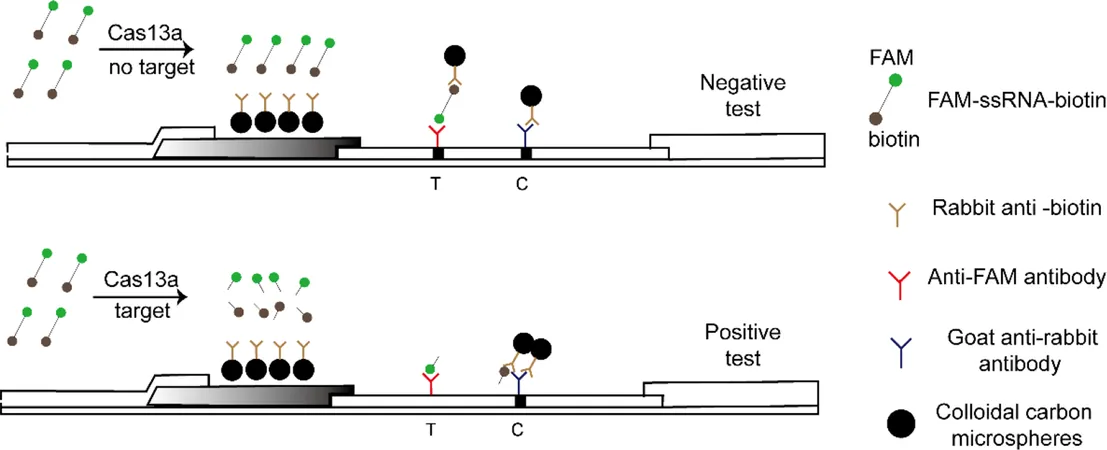
Revolutionary Test Strips: Detecting Respiratory Viruses Using CRISPR-Cas13a
2025-06-12
Author: Arjun
The Respiratory Virus Challenge
Acute respiratory infections are surging globally, severely impacting public health, particularly among the elderly, infants, and those with chronic conditions. Key culprits include a variety of RNA viruses like influenza, coronaviruses, and rhinoviruses, which not only cause acute illness but can also lead to chronic respiratory conditions.
COVID-19's Global Impact
The COVID-19 pandemic, driven by SARS-CoV-2, has led to staggering statistics: 775 million infections and over 7 million deaths worldwide. Rapid and reliable diagnostic methods are vital for controlling the spread, but standard tests like RT-qPCR, while precise, are often too slow for effective on-the-spot testing.
Enter CRISPR-Cas13a Technology
Innovations in virus detection are coming from the CRISPR-Cas system, specifically the Cas13a protein, which allows for rapid and accurate detection of viral RNA without the need for amplification. Traditional methods utilizing gold markers can be expensive, prompting researchers to explore colloidal carbon as a cost-effective alternative.
Developing a Game-Changer Test Strip
Recent advancements have led to the creation of a colloidal carbon immunochromatographic test strip capable of detecting multiple respiratory viruses, including SARS-CoV-2 and H3N2 influenza. These strips are designed to be affordable, portable, and highly sensitive—offering a promising solution for both clinical and at-home testing.
Validation and Efficacy
In extensive testing with clinical samples, the new test strips demonstrated impressive accuracy compared to RT-qPCR results, confirming their potential for on-the-spot virus identification. By analyzing nine samples of SARS-CoV-2, the test yielded results consistent with existing gold standards—showing the reliability of this new approach.
Mechanics of the Test Strip
The unique 'elimination method' employed in this test indicates positive results through the absence of visual bands, leveraging the cutting abilities of Cas13a. As probes react with specific viruses, the test's visual output becomes clear, making it easy to interpret.
Future Directions and Optimizations
While the current method holds a detection limit of about 381.75 copies/μL, which is lower than RT-qPCR but faster and simpler, future research will aim to further enhance its sensitivity. As more clinical samples are tested, the method's accuracy and applicability in diverse settings will improve, alongside the incorporation of robust quality control measures.
A New Dawn for Virus Detection
This innovative CRISPR-based approach promises significant advantages: no amplification is needed, reducing contamination risks, and it's capable of detecting multiple virus strains simultaneously. As researchers continue to refine this technology, its potential for widely accessible, rapid testing in varied settings could revolutionize how we manage respiratory viruses.



 Brasil (PT)
Brasil (PT)
 Canada (EN)
Canada (EN)
 Chile (ES)
Chile (ES)
 Česko (CS)
Česko (CS)
 대한민국 (KO)
대한민국 (KO)
 España (ES)
España (ES)
 France (FR)
France (FR)
 Hong Kong (EN)
Hong Kong (EN)
 Italia (IT)
Italia (IT)
 日本 (JA)
日本 (JA)
 Magyarország (HU)
Magyarország (HU)
 Norge (NO)
Norge (NO)
 Polska (PL)
Polska (PL)
 Schweiz (DE)
Schweiz (DE)
 Singapore (EN)
Singapore (EN)
 Sverige (SV)
Sverige (SV)
 Suomi (FI)
Suomi (FI)
 Türkiye (TR)
Türkiye (TR)
 الإمارات العربية المتحدة (AR)
الإمارات العربية المتحدة (AR)